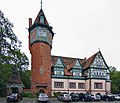Hannoversche Landwehr
The Hannoversche Landwehr was part of the border security system in the run-up to the city fortifications of Hanover . The Landwehr from a hedge-lined wall with a moat probably surrounded the entire medieval city of Hanover . Remnants can only be found in the eastern part of the Eilenriede city forest . There were waiting towers and houses at the passageways, most of which have been preserved as excursion restaurants.
Emergence

In the middle of the 14th century , against the background of the War of the Lüneburg Succession (1370-1388), a Landwehr was created to protect Hanover as an advanced fortification system with waiting towers. In the great privilege of 1392, the city of Hanover was expressly granted the right to build land weirs to fortify it. The area between the towers was protected by earthworks and trenches with hedges and Knicks were planted. The Landwehr probably surrounded the whole of Hanover, only parts of the forest area of the Eilenriede have survived . The first, about 8 km long section was built around 1341 as the "Lüneburger Landwehr" with the ship moat that is still preserved today . It ran roughly parallel to today's Messeschnellweg to the north-east from the former Warthaus Steuerdieb in the Eilenriede to the Altwarmbüchener Moor . In 1373 the Landwehr was built to Misburg with a length of about 2 km. Other subsystems were the "Hohe Landwehr" and the "Spitze Landwehr" between the Döhrener and Kirchröder towers. The former ditch of the Landwehr has been preserved to this day in the Landwehrgraben on the southern edge of the Eilenriede.
Towers and waiting areas
Waiting towers
- Döhrener Tower from 1382
- Horse tower from 1387
- Lister Tower from 1387
- Linden Tower from 1392
Linden tower ( Merian engraving from 1654)
Waiting houses
- Warthaus Pinkenburg from 1340
- Warthaus tax thief from 1392
Pinkenburg in Groß-Buchholz , today a restaurant
Destroyed waiting towers or houses
- Kirchröder Tower from 1378
- Keep at the Mortmole (Murder Mill) from 1385
- Red Tower from 1441
- Bischofsholer Tower from 1460
- Keep Grottemekere Campe
Kirchröder Tower in Kirchrode
Bischofshol , today a forest restaurant in the Waldheim district
The watch tower of Bischofshol was built around 1460 and named after the Hildesheim bishop . Around 1760, a half-timbered house with forest management was built on the site of the no longer existing tower for the Eilenriede forester, which was rebuilt as an excursion restaurant after the building was demolished in 1967/68 with a hotel.
Task of the Landwehr
Although the Landwehr was created for military reasons, it mainly served to protect trade routes with customs duties , control of wood, huck and pasture use and as a border marker against the surrounding area. It was also supposed to prevent stray rabble from entering. In addition to the Landwehr towers, there were inns from the start . The Kruger had to keep food and drink ready for those passing through. They also exercised sovereign functions by observing the apron of the city and keeping the barriers closed at night . Many waiting rooms have retained their former gastronomic function to this day and have been transformed into tourist restaurants.
The military value of the Landwehr was not too high. During the attack by Duke Heinrich the Elder in 1486, the Döhrener tower and its crew were burned (see: Siebenmännerstein ). However, the city was not conquered.
After the Middle Ages , the military forces gradually lost their importance. Their watchtowers became foresters to curb wood theft in the Eilenriede. When the city of Hanover expanded into the surrounding area, the walls were demolished as a result of construction activity. Well-preserved wall and ditch sections are in the areas of the horse tower, the Döhrener tower and the island ditch behind the zoo .
literature
-
Arnold Nöldeke : Fortification , in which: The art monuments of the province of Hanover (= booklet 19 of the complete work), Part 1: Region of Hanover , Booklet 2 in two parts: City of Hanover, Part 1: Monuments of the "old" city area of Hanover (incorporation status up to January 1, 1870) , Hanover: Self-published by the Provinzialverwaltung, Theodor Schulzes Buchhandlung, 1932, pp. 63–67
- (Reprint: Osnabrück, Wenner, 1979, ISBN 3-87898-151-1 )
- Prospectus: Hanover's Landwehr , Hanover, 1984, publisher: Lower Saxony State Administration Office, Institute for Monument Preservation
- Hans-Wilhelm Heine : The medieval Landwehr of Hanover . In: Guide to Prehistoric and Protohistoric Monuments. Volume 49. Part II Excursions . Mainz 1981
Web links
- Photos and text at the National Association for Prehistory
- Interactive tour of the Landwehr Hannover with city boards









